Abstract
A total of 568 strains of Escherichia coli isolated from healthy and diarrheic rabbits were separated into 11 different biotypes according to the fermentation patterns of four carbohydrates. Strains belonging to biotypes 1 to 3, 6, and 8 induced lesions characteristic for attaching and effacing E. coli (AEEC). They attached to the intestinal epithelium of the terminal small intestine and the large intestine of 5-week-old rabbits after experimental infection and caused effacement of the microvillous brush border. However, pathogenicity for weaned rabbits, as judged by diarrhea score, anorexia, and reduced weight gain, varied according to the biotypes of the strains. Strains belonging to biotypes 1 and 6 produced only discrete clinical signs, strains belonging to biotypes 2 and 3+ (motile) induced diarrhea and growth depression, whereas strains belonging to biotypes 3- (immotile) and 8 caused severe clinical signs and high mortality. This confirms evidence from the field. Biotypes 3- and 8, accounting for 35.5 and 7.1% of AEEC strains in weaned diarrheic rabbits, respectively, were not detected in weaned healthy rabbits, while biotype 2 was the predominant strain in weaned healthy rabbits (62.3%). Finally, serotyping showed a close relationship between biotype and serotype of the AEEC examined. Most strains of biotypes 1+ and 2+ tested were O109:K-:H2 and O132:K-:H2, respectively, whereas all strains tested of biotype 3- were O15:K-:H- and those of biotype 8 were O103:K-:H2. These data indicate that specific clones of AEEC might be involved in juvenile rabbit enteritis. It was concluded that determination of biotypes allows the screening of highly pathogenic AEEC in weaned rabbits (biotypes 3- and 8).
Full text
PDF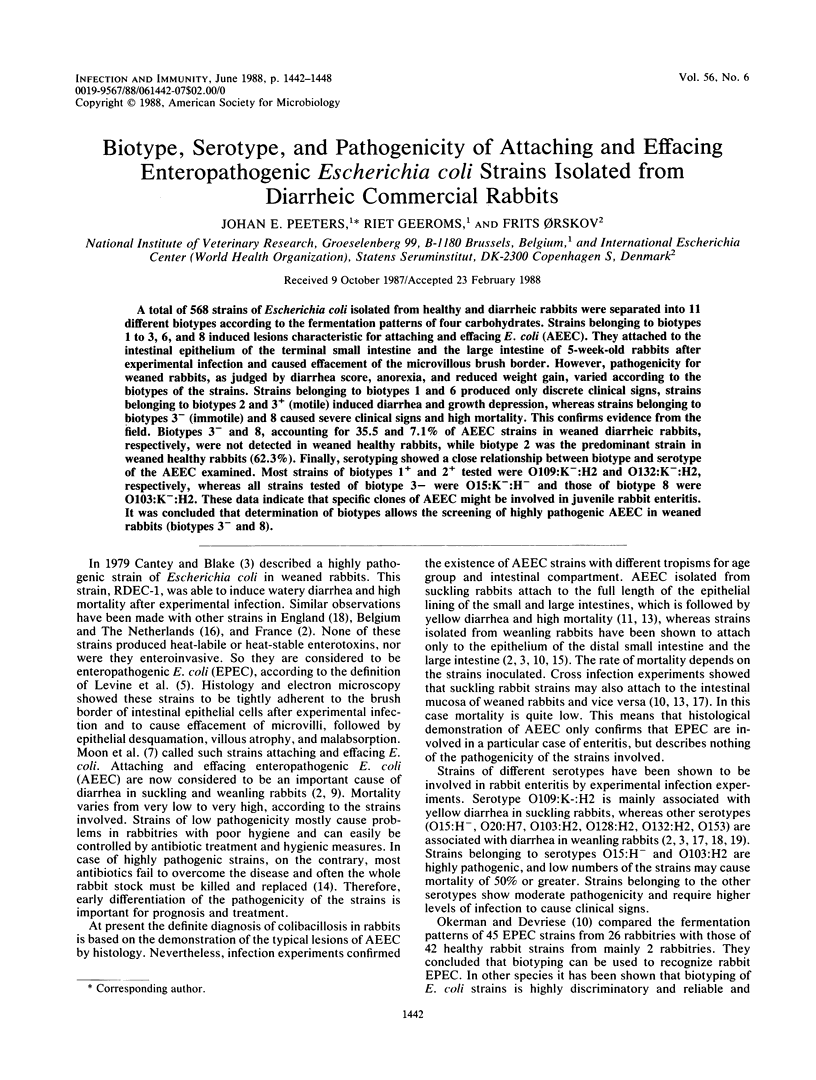
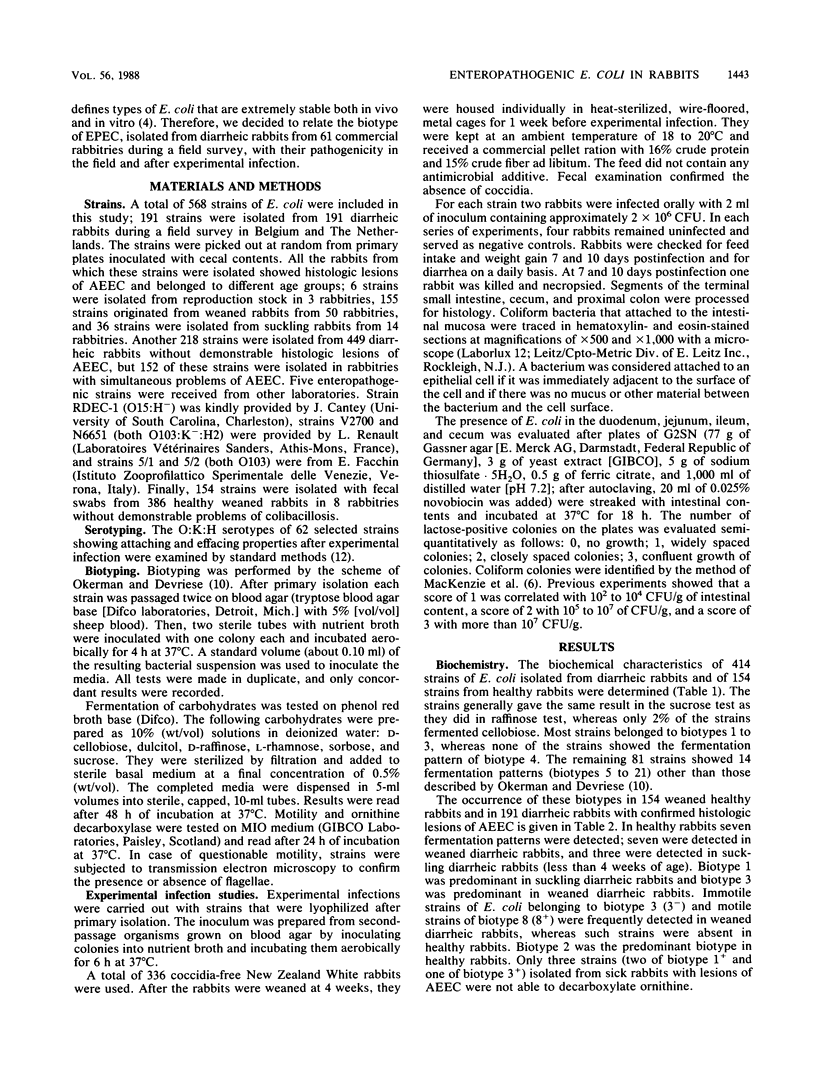

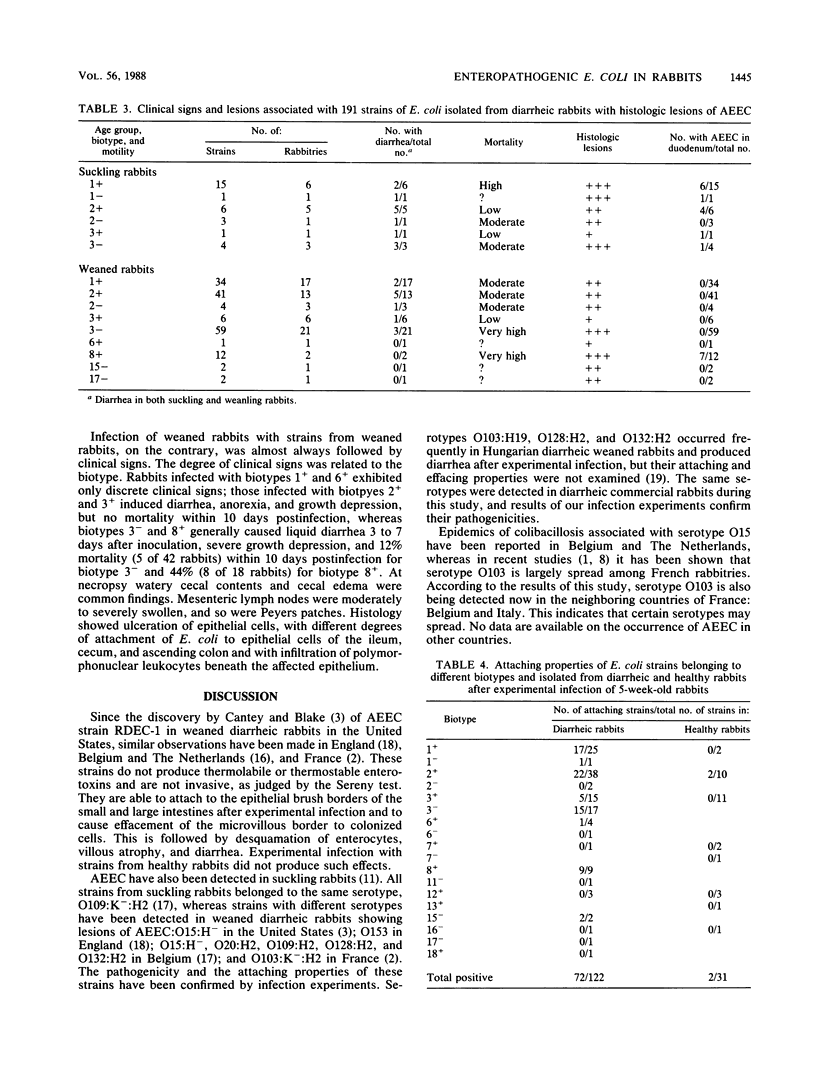
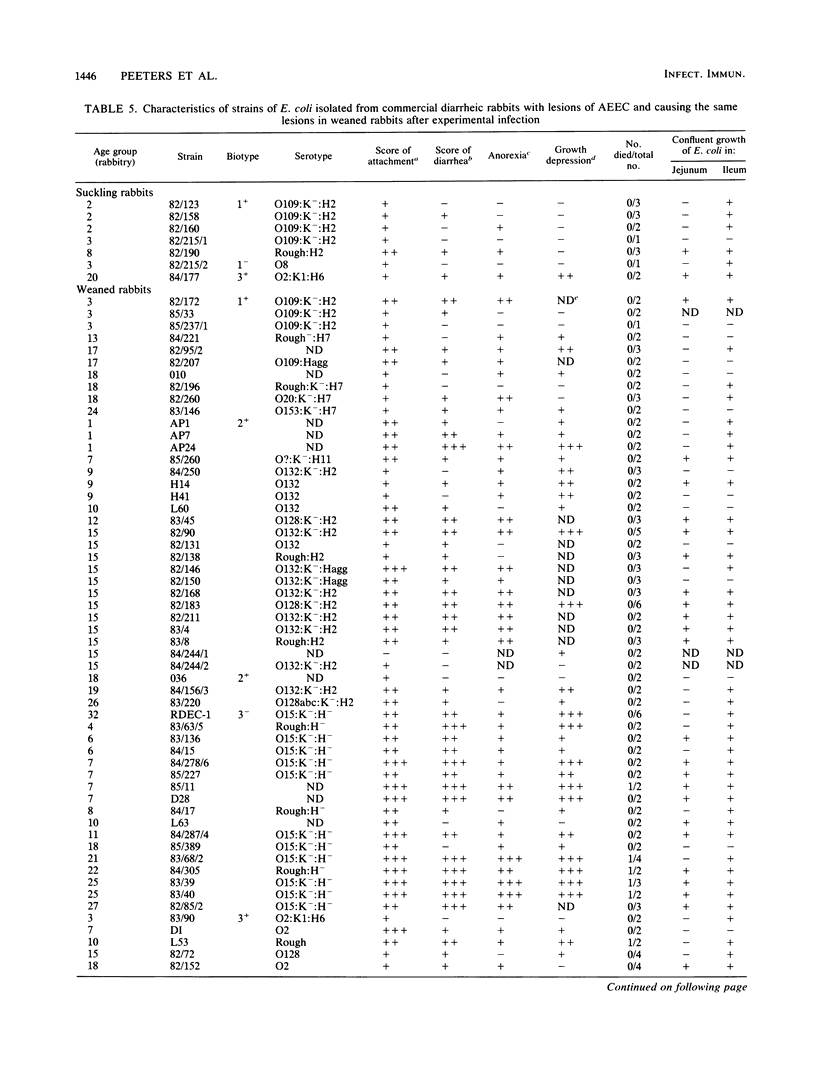
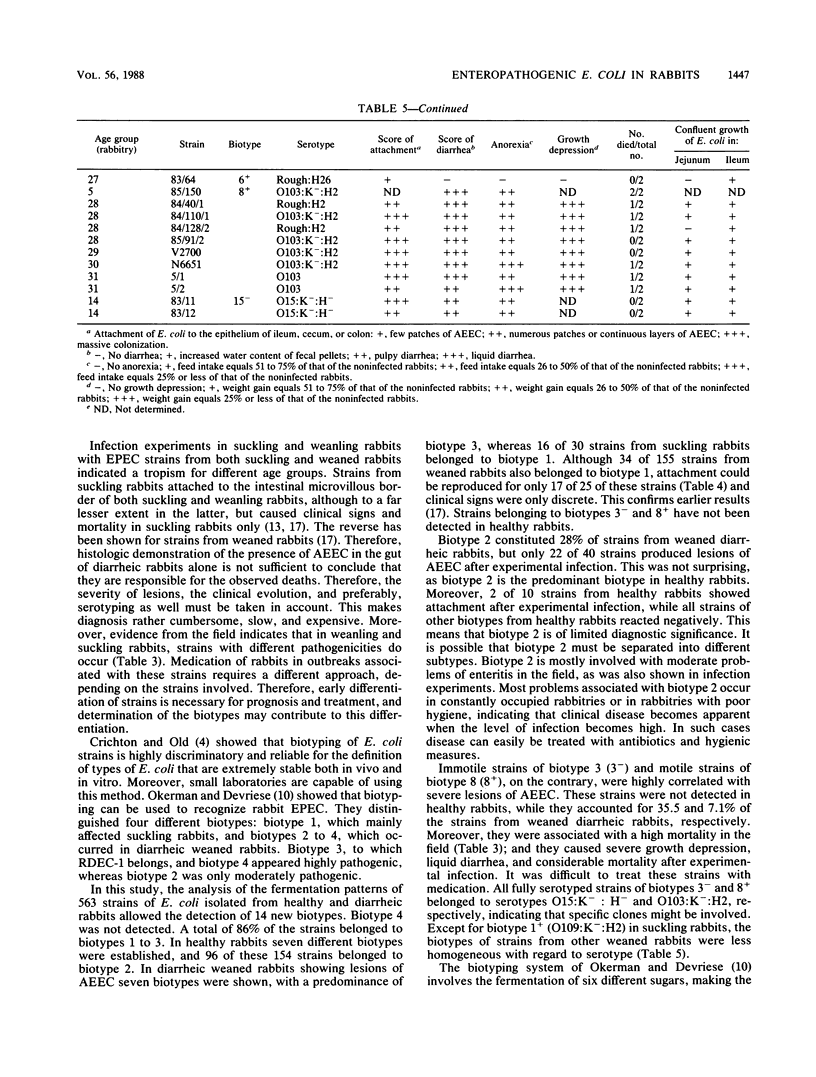
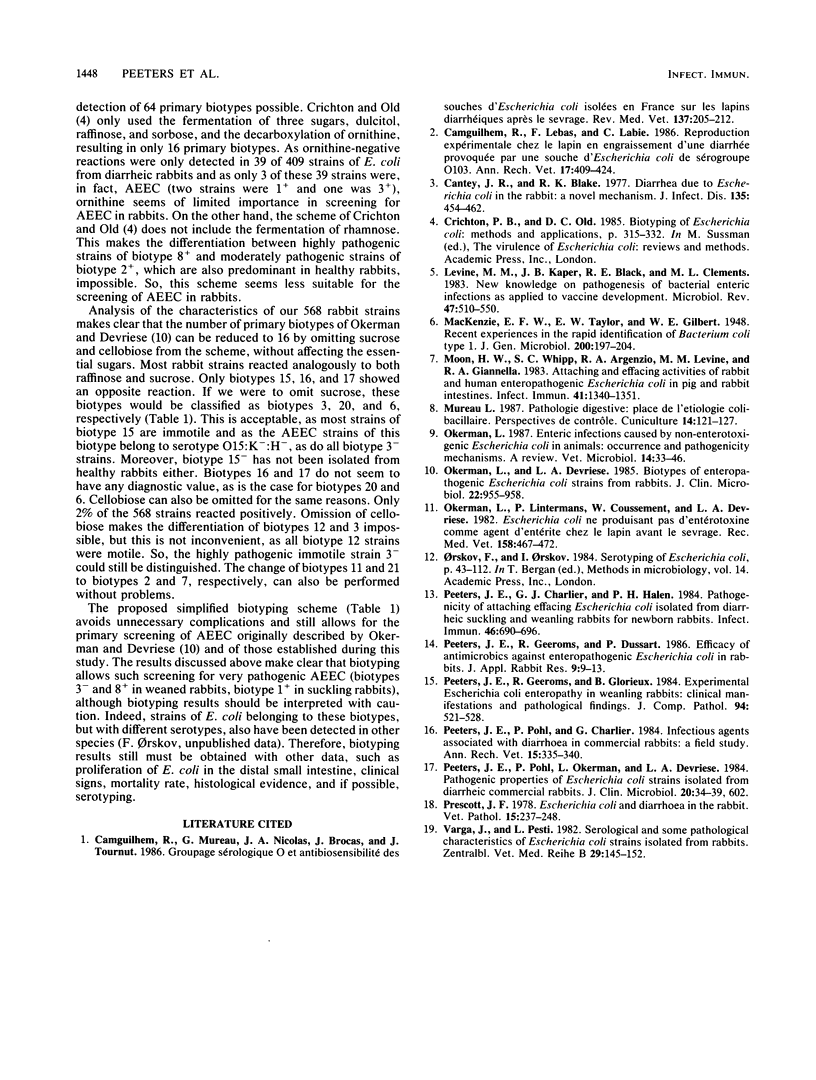
Selected References
These references are in PubMed. This may not be the complete list of references from this article.
- Camguilhem R., Lebas F., Labie C. Reproduction expérimentale chez le lapin en engraissement d'une diarrhée provoquée par une souche de Escherichia coli de sérogroupe O-103. Ann Rech Vet. 1986;17(4):409–424. [PubMed] [Google Scholar]
- Cantey J. R., Blake R. K. Diarrhea due to Escherichia coli in the rabbit: a novel mechanism. J Infect Dis. 1977 Mar;135(3):454–462. doi: 10.1093/infdis/135.3.454. [DOI] [PubMed] [Google Scholar]
- Levine M. M., Kaper J. B., Black R. E., Clements M. L. New knowledge on pathogenesis of bacterial enteric infections as applied to vaccine development. Microbiol Rev. 1983 Dec;47(4):510–550. doi: 10.1128/mr.47.4.510-550.1983. [DOI] [PMC free article] [PubMed] [Google Scholar]
- Moon H. W., Whipp S. C., Argenzio R. A., Levine M. M., Giannella R. A. Attaching and effacing activities of rabbit and human enteropathogenic Escherichia coli in pig and rabbit intestines. Infect Immun. 1983 Sep;41(3):1340–1351. doi: 10.1128/iai.41.3.1340-1351.1983. [DOI] [PMC free article] [PubMed] [Google Scholar]
- Okerman L., Devriese L. A. Biotypes of enteropathogenic Escherichia coli strains from rabbits. J Clin Microbiol. 1985 Dec;22(6):955–958. doi: 10.1128/jcm.22.6.955-958.1985. [DOI] [PMC free article] [PubMed] [Google Scholar]
- Okerman L. Enteric infections caused by non-enterotoxigenic Escherichia coli in animals: occurrence and pathogenicity mechanisms. A review. Vet Microbiol. 1987 May;14(1):33–46. doi: 10.1016/0378-1135(87)90050-2. [DOI] [PubMed] [Google Scholar]
- Peeters J. E., Charlier G. J., Halen P. H. Pathogenicity of attaching effacing enteropathogenic Escherichia coli isolated from diarrheic suckling and weanling rabbits for newborn rabbits. Infect Immun. 1984 Dec;46(3):690–696. doi: 10.1128/iai.46.3.690-696.1984. [DOI] [PMC free article] [PubMed] [Google Scholar]
- Peeters J. E., Geeroms R., Glorieux B. Experimental Escherichia coli enteropathy in weanling rabbits: clinical manifestations and pathological findings. J Comp Pathol. 1984 Oct;94(4):521–528. doi: 10.1016/0021-9975(84)90056-2. [DOI] [PubMed] [Google Scholar]
- Peeters J. E., Pohl P., Charlier G. Infectious agents associated with diarrhoea in commercial rabbits: a field study. Ann Rech Vet. 1984;15(3):335–340. [PubMed] [Google Scholar]
- Peeters J. E., Pohl P., Okerman L., Devriese L. A. Pathogenic properties of Escherichia coli strains isolated from diarrheic commercial rabbits. J Clin Microbiol. 1984 Jul;20(1):34–39. doi: 10.1128/jcm.20.1.34-39.1984. [DOI] [PMC free article] [PubMed] [Google Scholar]
- Prescott J. F. Escherichia coli and diarrhoea in the rabbit. Vet Pathol. 1978 Mar;15(2):237–248. doi: 10.1177/030098587801500210. [DOI] [PubMed] [Google Scholar]
- Varga J., Pesti L. Serological and some pathological characteristics of Escherichia coli strains isolated from rabbits. Zentralbl Veterinarmed B. 1982 Mar;29(2):145–152. doi: 10.1111/j.1439-0450.1982.tb01209.x. [DOI] [PubMed] [Google Scholar]


